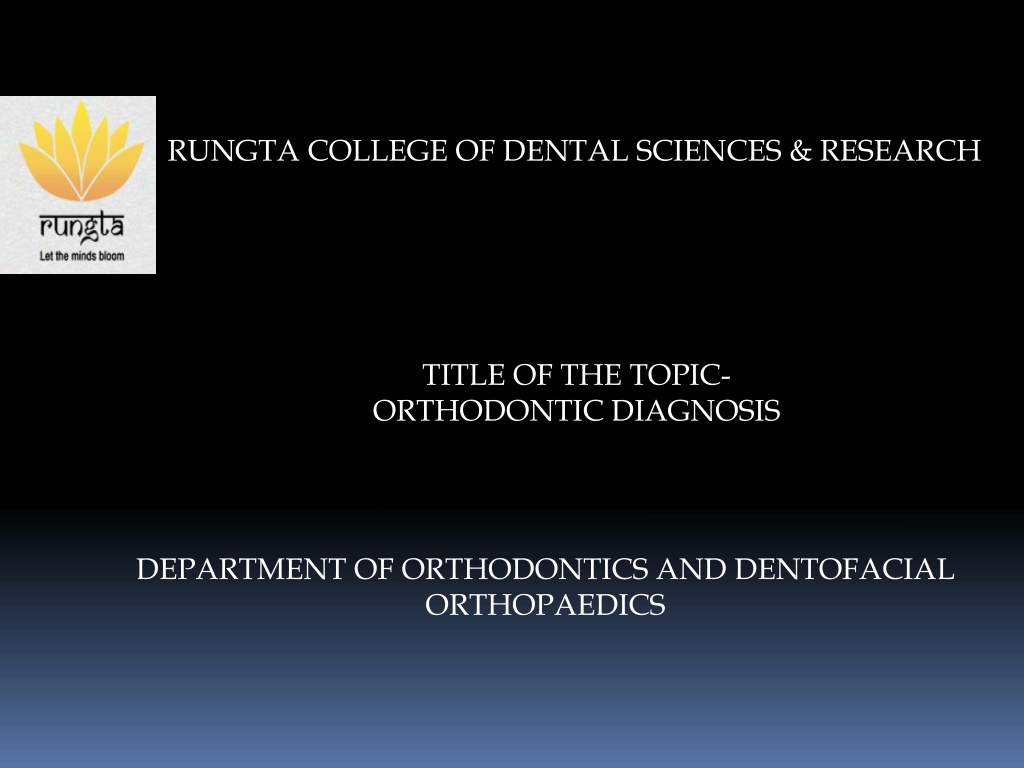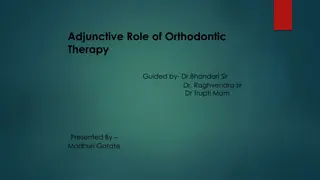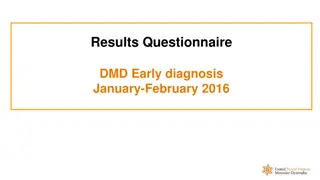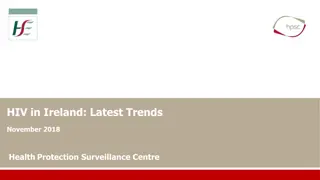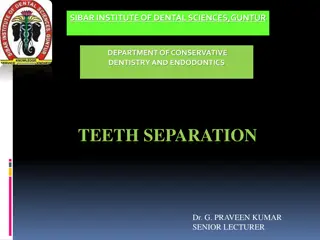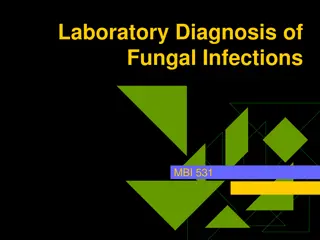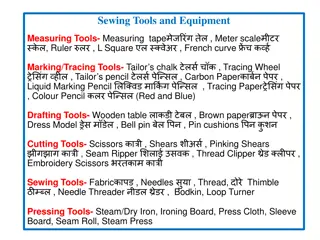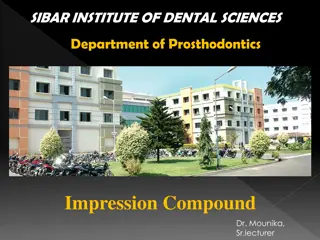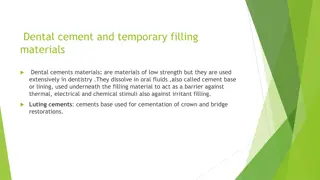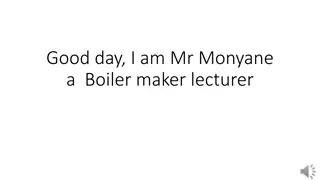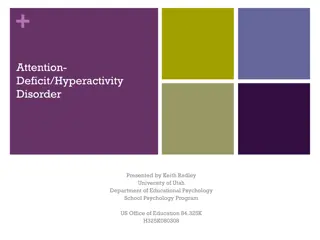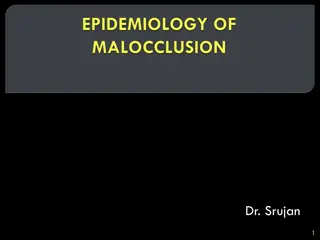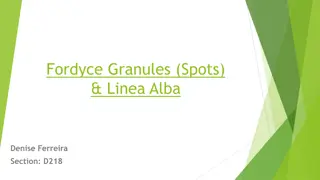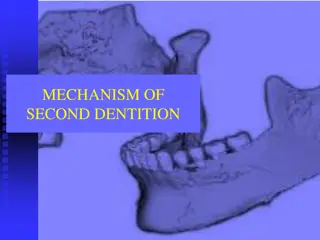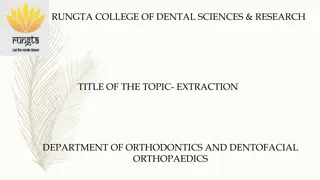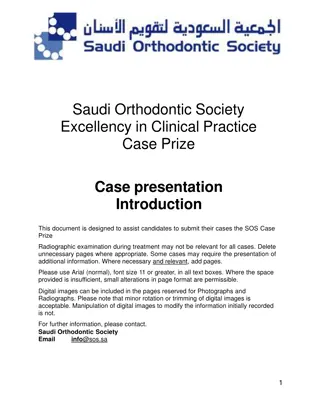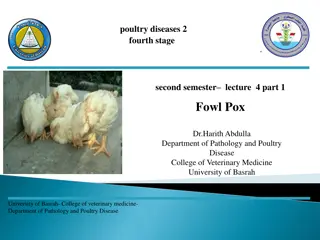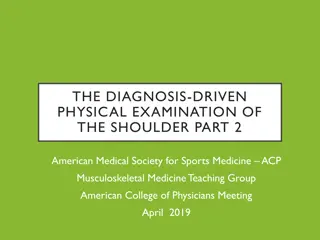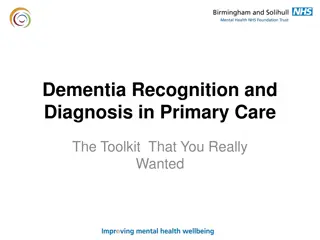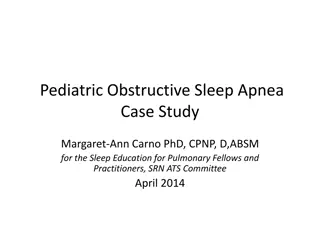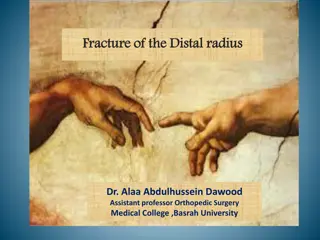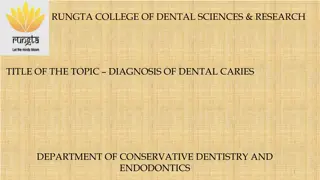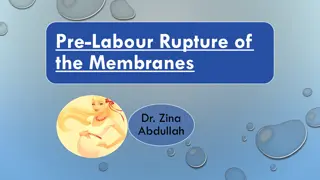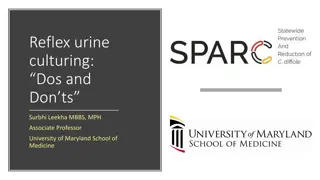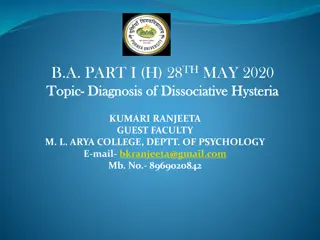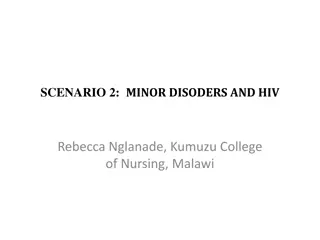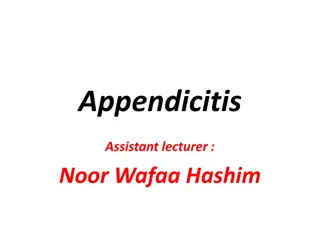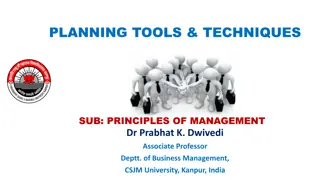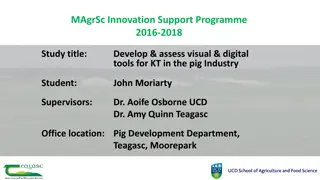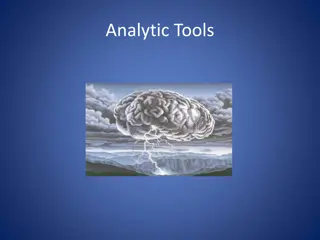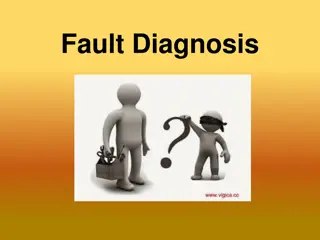Orthodontic Diagnosis: Essential Tools and Techniques
This detailed guide covers essential diagnostic aids for orthodontic diagnosis, including case history, general examination, intraoral examination, supplemental diagnostic aids, orthodontic study models, diagnostic setups, facial photographs, electromyography, radiographs, recent advances, and more. It provides a comprehensive overview of the key areas crucial for effective orthodontic diagnosis.
Download Presentation

Please find below an Image/Link to download the presentation.
The content on the website is provided AS IS for your information and personal use only. It may not be sold, licensed, or shared on other websites without obtaining consent from the author. Download presentation by click this link. If you encounter any issues during the download, it is possible that the publisher has removed the file from their server.
E N D
Presentation Transcript
RUNGTA COLLEGE OF DENTAL SCIENCES & RESEARCH TITLE OF THE TOPIC- ORTHODONTIC DIAGNOSIS DEPARTMENT OF ORTHODONTICS AND DENTOFACIAL ORTHOPAEDICS
Specific learning Objectives CORE AREAS DOMAIN CATEGORY ESSENTIAL DIAGNOSTIC AID AFFECTIVE DESIRE TO KNOW CASE HISTORY COGNITIVE MUST KNOW ORTHODONTIC STUDY MODELS PSYCHOMOTOR NICE TO KNOW NICE TO KNOW DIAGNOSTIC SET UP PSYCHOMOTOR DESIRE TO KNOW RECENT ADVANCES AFFECTIVE
CONTENTS Introduction PART I Essential diagnostic aids Supplemental diagnostic aids CASE HISTORY : Personal Detail, Chief Complaint, Medical History, Dental history, Prenatal & Postnatal history, Family history. General Examination : Body build Extraoral Examination: Facial form, facial symmetry, facial profile,facial divergence, assessment of posterior jaw relationship, assessment of vertical skeletal relation, evaluation of facial proportion , examination of lips , examination of nose , examination of chin and nasolabial angle Intraoral examination : Examination of Tongue , palate , gingiva , frenal attachment , tonsils & adenoids , Assessment of dentition , Functional examination , assessment of postural rest position and inter-occlusal clearance , methods used to record postural rest position , methods to measure inter-occlusal clearance , Evaluation of path of closure , assessment of repiration , examination of TMJ , Evaluation of Swallow & speech
PART II Orthodontic study models Diagnostic setups PART III Supplemental diagnostic aids : Facial photographs as diagnostic aids , Electromyography , Radiographs in Orthodontics Recent advances in Orthodontics Summary
EXAMINATIONOFLIPS The upper lip covers the entire labial surface of upper anteriors excepttheincisal2-3mm The lower lip covers the entire labial surface of lower anteriors and 2-3mmof incisaledge of upperanteriors.
CLASSIFICATIONOFLIPS Competent lip-the lips are in slight contact when musculature is relaxed.
INCOMPETENTLIPS- theyaremorphologically short lips which do not forma lipseal ina relaxedstate. The lip seal can only be achieved by active contractionofperioraland mentalismuscle.
POTENTIALLYINCOMPETENT LIP-they are normal lips that fails to forma lipseal due to proclaimed upperincisor. EVERTED LIP-they are hypertrophied lips with weak muscular tonicity.
EXAMINATIONOFTHENOSE Thenose to a large extend contributes to the esthetic appearance ofa face. Nose size-normally the nose is one third of the total facialheight. Nasal contour-the shape of the nose can be straight, convexorcrookedasa resultof nasal injuries. Nostrils-they are oval and should be bilaterally symmetrical. Stenosis of the nostrils may indicate impaired nasalbreathing.
EXAMINATION OF CHIN MENTOLABIAL below the lower lip. Deep mentolabial sulcus is seen in class11,divison 1 malocclusion. MENTALIS ACTIVITY-normaIly mentalis is not active at rest. Hyperactive mentalis is seen in class II divison 1 cases. CHIN POSITION AND prominent chin is usually associated with class III malocclusion. SULCUS-concavity seen PROMINENCE- DEEP MENTOLABIAL SULCUS AND HYPERACTIVE MENTALIS SEEN IN CLASSII DIVISON 1 MALOCCLUSION
NASOLABIAL ANGLE It is the angle formed between lower border of the nose and a line connecting the intersectionof nose and the upper lip with the tip of the lip. This angle is normally110degree. It reducesinpatientswith proclaimed upper Incisors prognathic maxilla.
INTRA-ORALEXAMINATION Examination of tongue Abnormalities of tongue can upset the muscle balance and equilibrium leading to malocclusion. A patient whose tongue can reach the tip of the nose is said to have a long nose. The lingual frenum should be examined for tongue tie.
EXAMINATION OFTHEPALATE Palate should be examined for the following findings; 1. Dolicofacial patients havedeep palate. 2. Presenceof swellingsinthepalate 3. Mucosal ulcerations and indentations are a featureoftraumatic deep bite. 4. Presenceofcleftinthepalate. 5. The third rugae is usually in line with canines. This is useful in the assessment of maxillary anteriorproclination.
EXAMINATION OF GINGIVA Gingiva should be examined for 1. Inflammation 2. Recession 3. Mucogingival lesions Poor oral hygeine is associated with anterior marginal gingivitis. Anterior gingivitis common in mouth breathers due to dryness of mouth caused by open lip posture.
EXAMINATIONOF FRENALATTACHMENTS The maxillary labial frenum sometimes be thick fibrous and attachedrelativelylow. This may lead to midlinediastema. Abnormal frenal attachment are diagnosed by blenchtest.
EXAMINATION OF TONSILS AND ADENOIDS Abnormaly inflamed tonsils cause alterations in tongue and jaw posture there by upsetting the oro-facial balance leading to malocclusion.
ASSESSMENT OF DENTITION Dental systemisexamined for; 1. Teethpresentintheoralcavity 2. Teethunerupted 3. Teeth missing 4. Teetherupted and not erupted 5. Presence of caries, restorations ,malocclusions, hypoplasia, wearand dislocation.
6. Check for the occlusion based on ANGLES CLASS I ,II ,III. 7. Record overbite over jet 8. Check for cross bite 9. Individual tooth irregularities such as rotation, displacement intrusion and extrusion are noted. 10.Check arch form.
FUNCTIONAL EXAMINATION It is now established that normal function of stomatognathic system promotes normal growth and development of oro-facial complex. Thefunctional examination should include the following; 1. Assessment of postural rest position and inter space. 2. Path ofclosure 3. Assessmentof respiration 4. Assessmentof TMJ 5. Examinationof swallowing 6. Examinationof speech. occlusal
ASSESSMENT OF POSTURAL REST POSITION AND INTER-OCCLUSAL CLEARANCE. The postural rest position of the mandible at which the muscles that closes the jaw and those that open them are, in state of minimal contraction to maintain the postureof mandible. At postural rest position, a space exists between the upperand lowerjaws. This space is known as FREEWAYSPACE. FREEWAYSPACE is 3mm incanineregion.
METHODS USED TO RECORD THE POSTURAL REST POSITION PHONETIC METHOD; the patient is asked to repeat some consonants m orc orrepeat a word like Mississippi. The mandible returns to postural rest position 1-2 seconds after theexercise. The patient is told not to change the jaw, lip or tongue position after phonation, as the dentist parts the lipsto study interocclusalspace.
COMMAND METHOD The patient is asked to perform certain functions such as swallowing. The mandible tends to return to rest position following this act.
Non commandmethod Thepatientis observed ashe speaksorswallows. The patient is no aware that he is being examined. This is usually being carried out by talking about topics unrelated to the patient while carefully observinghimornot.
METHODS TO MEASURE INTER- OCCLUSAL CLEARANCE Vernier calipers can be used directly in the patient s mouth in the canine or Incisal region to measure freeway space. This is direct intra oral method.
EVALUATION OF PATH OFCLOSURE The path of closure is the movement of mandible from the rest positiontohabitualocclusion. Forward path of closure:a forward path of closure occurs in patients with mildskeletaland incisor contact. In such patients ,the mandible is guided to a more forward position to allow the mandibular incisors to go labial to the upperincisors. prenormalcy or edge to edge Backward path of closure: class 11 ,division 2 exhibit premature incisor contact due to retroclined maxillary incisors. Thus the mandibleis guided posteriorlyto establishocclusion Lateral path of closure : lateral deviation of mandible to left or rightsideisassociatedwithocclusal narrow maxillaryarch. prematurities and a
ASSESSMENT OFRESPIRATION Humansmayexhibit three types of breathing:nasal,oral and oro-nasal Test to diagnose the mode of respiration: Mirror test : a double sided mirror is held between the nose and the mouth .fogging on the nasal side of the mirror indicates nasal breathing while fogging towards oral side indicates oralbreathing Cotton test:a butterfly shaped cotton piece isplaced over the upper lip below the the nostrils . if the cotton flutters down indicates nasal breathing. this test is used to determine the unilateral nasal blockage.
WATER TEST - the patient is asked to fill his mouth with water and retain it for a long period of time .while nasal breathers accomplish this with ease , mouth breathers find it difficult task.
Observation : in nasal breathers the external nares dilate during inspiration .in mouth breathers ,there is either no change in the externalnaresortheymayconstrict during inspiration EXAMINATIONOFT.M.J. The functional examination should routinely include auscultation and palpationof temporomandibular associated with mandibularopening. The patient should be examined for the symptoms of joint problems likeclicking, crepitus, painof masticatory muscles, limitationofjaw movement, hyper-mobilityand morphologicalabnormalities. The maximum mouth opening is determined by measuring distance between the maxillary and mandibular incisal edges with mouth wideopen. Thenormal interincisaldistance is 40-45mm. joint and musculature the
EVALUVATION OFSWALLOWING In a new born, tongue isrelatively large and protrudes between the gumpads and takes part inestablishing the lip seal .thiskindof swallowis called infantile swallow and is seen half to twoyear sof age . Infantile swallow is replaced by mature swallow as the buccal teeth start erupting. The persistence of infantile swallowing can cause malocclusion .thus the swallowing individualshouldbe examined. The persistence of the infantile swallow is indicated by the presenceof the followingfeatures: Protrusionof the tip oftongue Contraction of perioral muscles duringswallowing No contact at themolarregion duringswallowing. till one and pattern of the a. b. c.
SPEECH malocclusions ..Certain may cause defects in speech due to interference with the movement of tongue and lips .thisshouldbeobserved whiletalking withthe patient. ..The patient can be asked to read out from a book or asked to count from 1-20 while observing the speech. ..Patients having tongue thrusthabit tend to lisp while cleft palate patients may have a nasaltone.
ORTHODONTIC STUDY MODELS Orthodontic studymodels are accurate plaster reproductions of teeth and their surrounding soft tissues .that are essential diagnostic aid that make itpossible to study the arrangement of teethand theocclusion from all directions. Usesof studymodelinclude: Theyenable studyofocclusionfromallaspect b) Enable accurate measurements to be made in dental arch.theyhelpinthemeasurement ofarchlength,archwidth ,and toothsize a) c) Helpinassessmentof treatmentprogressbydentistaswellasby patient d) Help inassessingthenatureand severityofmalocclusion e) Helpful in motivation of patient and to explain the treatment plan aswell as progressto patient andparents f) Makes itpossible tostimulatetreatment procedures oncast such as mocksurgery g) Useful to transfer records in case patient is treated by another clinician.
GNATHOSTATICMODELS They are orthodontic study models where the base of maxillary cast is trimmed to correspond to the horizontalplane. the Frankfort DIAGNOSTICSET UP Itwas firstpropose by H.D.kesling Diagnostic set up is made from an extra set of trimmed and polished study models .the individual teeth and their associated alveolar processes are sectioned off and replaced on the model base in the desired positions .the diagnostic set up thus help in simulating the various tooth movements that are planned for patients.
USES OF DIAGNOSTIC SET UP Useful in visualizing and testing the effect of complex tooth movements and extractions on the occlusion Patient can be motivated by simulating the various corrective procedures in the cast Tooth size-arch length discrepancies can be visualized PROCEDURE 1. The cast is cut using a fretsaw blade to separate the individualteeth. 2.A horizontal cut is made 3mm apical to gingival margin Vertical cuts are made individual teeth. The individual teeth are set in desired position usinga red wax. 1. 2. 3. to separate the
SUMMARY Orthodontic examination and diagnosis start first with formal and informal meeting with child and parents. A detailed history is followed by a detailed, intricate examination of physical growth, face,soft tissues and oral cavity, including functions of stomatognathic systems. A close and diligent clinical study evaluation of malocclusion and functional examination is a critical component of orthodontic diagnosis. A detailed examination cannot be done in a hurry and would require each of the listed components to be recorded and evaluated for its possible impact on oral health and orthodontic treatment. The clinical examination is followed by making required records and investigations leading to a comprehensive diagnosis and treatment plan.
REFERENCES Textbook of Orthodontics Gurkeerat Singh, Jaypee Brothers; 2nd Edition Orthodontics The Art and Science, S.I Bhalajhi, AryaMedi Publishing; 7th Edition Textbook of Orthodontics Sridhar Premkumar, Elsevier; 1st Edition Orthodontics: Diagnosis and Management of Malocclusion and Dentofacial Deformities O.P Kharbanda, Elsevier; 1st Edition
